ima Lure Selections for Bass Fishing

by Russ Bassdozer
This shows and tells product photos, product descriptions and
information for the lure models and colors that are (or have
been) available at BassdozerStore.com. Not all models and colors
shown are currently available, and exact specifications are
subject to change.
Note: Some of the following configurations may not all be
currently in stock. Some may be sold out at this time. Please
check online at www.BassdozerStore.com
for current availability of specific items below. Thank you for
your business.
ima Roumba ~ Topwater Crankbait
The Rumba is a high tempo, fast-stepping and seductive dance,
and that describes the overcharged action of the ima Roumba too.

It cuts a rug across the top with a high energy, non-stop
display of surface sidestepping intended to excite and arouse
bass to dance with it.

ima Roumba lure designer Fred Roumbanis
The Roumba has a unique, pudgy look. Once you get over its odd
shape and throw it, you'll find it is very versatile.
It may be used at any retrieve speed ranging from as slow as
possible, barely crawling it across the surface - to as blazingly
fast as possible. It excels at any speed. However, where the
Roumba breaks away from the pack and leaves the other topwaters
behind is that you can work it faster most any other topwater out
there. There are times that speed is the trigger, and it is tough
to figure out when. There are times that even lethargic fish that
won't go for anything else, they'll go for an incredibly fast
speed Roumba with raw instinctive reaction strikes.
There's really no need to give the Roumba any additional rod
tip action. All the wild and seductive gyrations are built right
into this new style topwater. thanks to ima lure designer and
bass pro Fred Roumbanis (shown above).
Due to the crankbait like bill, the Roumba has more
side-to-side action on its own, just reeling the Roumba steadily,
than most other topwater lures. Unlike crankbaits, the bill is
not designed to make the Roumba dive. The bill really only
imparts side-to-side action to the bait. It causes the Roumba to
move rapidly side-to-side, so it does not need to be reeled and
moved forward quickly, and there is no need to give it action
with the rod tip. All the fantastic action is already built right
into the Roumba for you.
- Body length is 3 inches (75 cm) long,
not counting the lip.
- Weighs 1/2 ounce (16 gr).
- Floats at rest.
- Extreme wobbling action.
Hold your rod tip high for best topwater action at any
retrieve speed from super slow to blazingly fast - and any speed
in between.
Hold the rod tip down to get the Roumba to dip under the
surface, and crank the Roumba in a little faster to get it under
about 1/2 foot or a foot deep.
No matter how you use it, the Roumba is a lure you should have
tied on whenever bass are belting topwaters - or even when they
aren't. Sometimes the need for speed is necessary to trigger bass
- but you'd never know it's there with regular lures. The Roumba
is one of the few topwaters that can move fast enough to get bit
then..
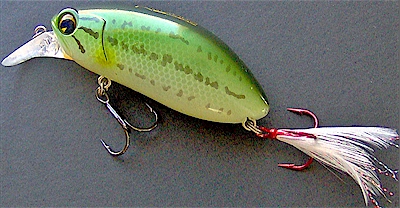
Replacing the tail with a feather treble (not included) improves
the lure's action.
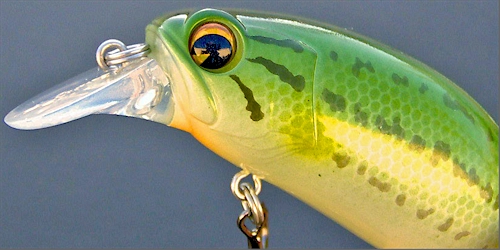
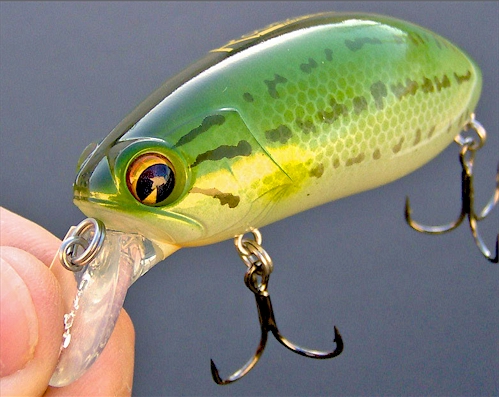
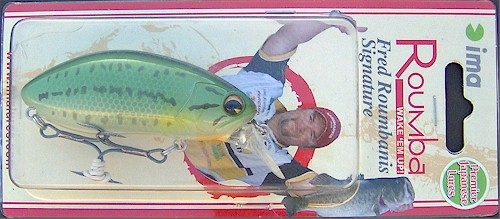
Ima Roumba ~ Topwater Crankbait ~ Baby Bass

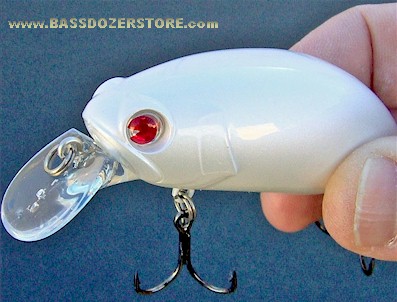
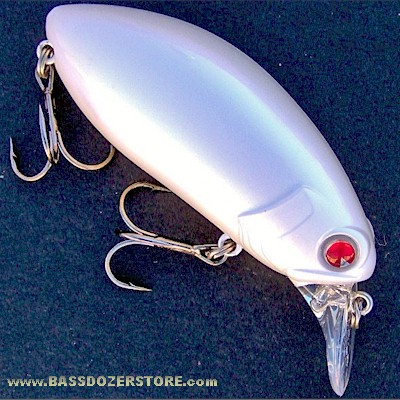
Ima Roumba ~ Topwater Crankbait ~ Albino


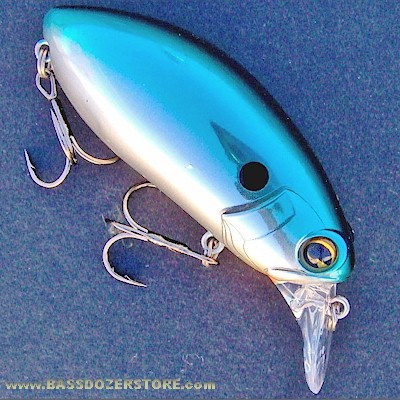
Ima Roumba ~ Topwater Crankbait ~ Gizzard Shad
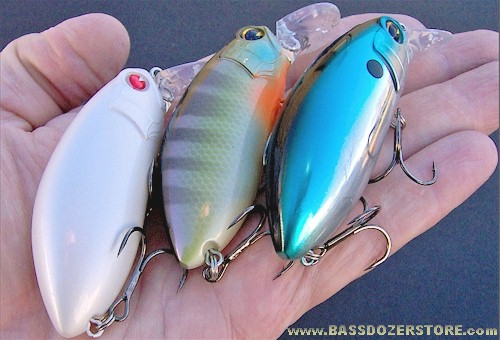

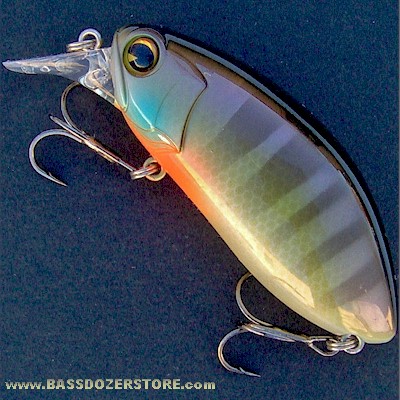
Ima Roumba ~ Topwater Crankbait ~ Bluegill

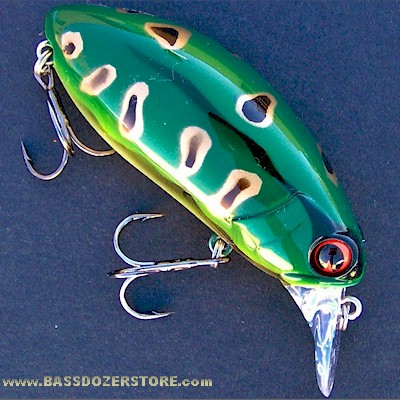
Ima Roumba ~ Topwater Crankbait ~ Bull Frog


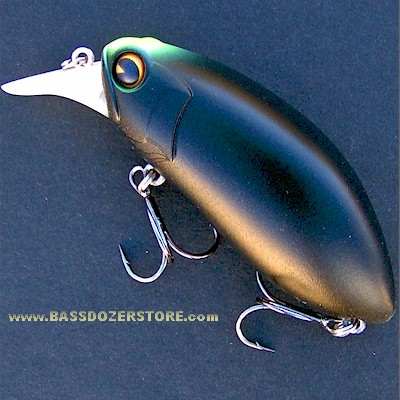
Ima Roumba ~ Topwater Crankbait ~ Stink Bug
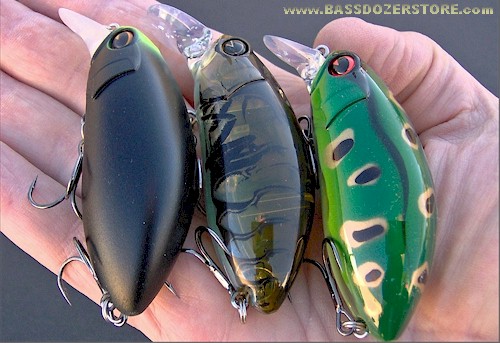

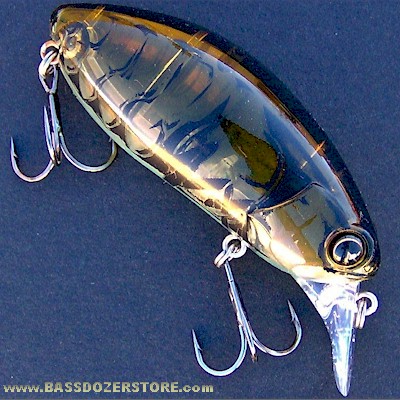
Ima Roumba ~ Topwater Crankbait ~ Real Crawfish
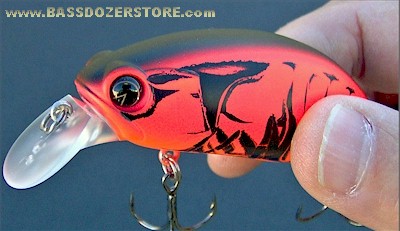
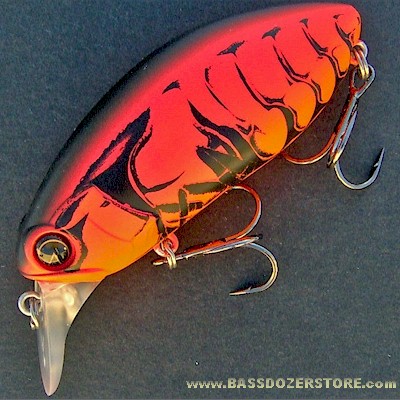
Ima Roumba ~ Topwater Crankbait ~ Hot Craw
ima Rattlin' Roumba ~ Topwater Crankbait
Model: Rattlin' Roumba
Type: Floating, Topwater Crankbait
Weight: 5/8 oz (16g)
Body Length: 3" (75mm) excluding lip
Factory Hooks: Two #4 Owner ST-36 Black Nickel
Depth: Topwater (rod tip up) to 12-18 inches (rod tip down)
Some of the reasons why anglers love the original non-rattling
Roumba are that it's so durable, has such a simple yet solid
construction, and it has one of the widest, most vigorous wobbles
of any topwater crankbait. The lip is not huge- but man does this
bait wobble, even better than baits with much bigger lips. Since
the Roumba's lip is small, it won't gunk up with grass as badly
as other big-lipped baits. The body is pretty fat, and it has
broad sides, which shield the hooks from grass and debris. So it
can come through thick grass surprisingly swell. It's streamlined
and aerodynamic, weighs 5/8 oz, and casts incredibly far. Last
but not least, it sports a great pair of hooks. Those are a few
of the reasons why the original non-rattling Roumba has become
something of a topwater sensation in a short time.
Now, the other, little noisier shoe has fallen - the Rattlin'
Roumba is here now!
The Rattlin' Roumba is everything the original Roumba is -
plus rattles. It has the same 3-inch size, the same weight, body
shape, hooks, lip and best of all, the same crazy, wide wobbling
action.
Everything about the original Roumba and the Rattlin' Roumba
are the same, except that the Rattlin' Roumba comes in six
different colors that rattle. The rattle is not excessively loud,
but creates a constant alluring, fish calling chatter.
So the Rattlin’ Roumba features six unique colors, including
some brighter colors that bass just can't miss in dirty water, in
conjunction with the rattling noise.
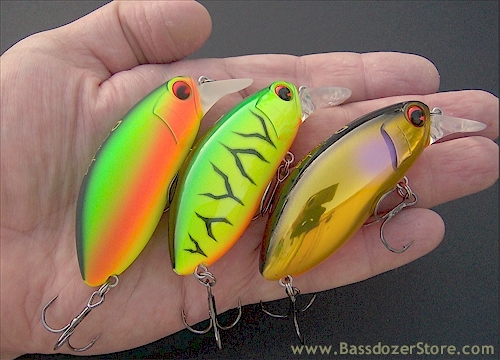
Rattlin' Roumba in bold fluorescent and black gold colors for low
light, thick cover, dark-colored water or at night.
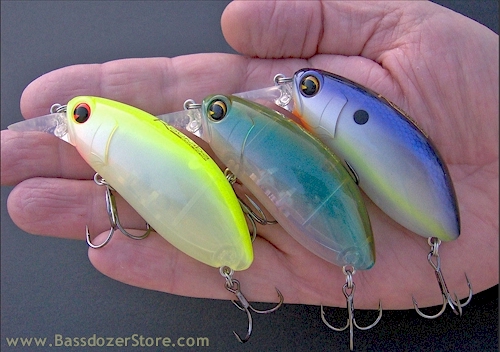
Rattlin' Roumba in lighter colors for clearer water, brighter
skies, sparser cover.
The original non-rattling Roumba will continue to be just as
good as it ever was, particularly with spooky, wary fish, in
clear water, under bright skies, out in the open, away from cover
and generally wherever and whenever topwater lures are working,
give the original Roumba a try.
The Rattlin' Roumba is the one to try in dark and dirty water,
around thick, grassy cover where bass can't see the surface so
well, under low light conditions or at night. Also, whenever rain
or strong wind suddenly muddies the water, try the Rattlin'
Roumba.
But most of all, remember this: We tend to want to make neat,
predictable rules for when different lure colors will work or for
when to use rattling lures versus non-rattling lures. Truth is,
there's no one who can make those kind of predictions with any
accuracy for any given day. You just need to try different
colors, and try the Rattlin' Roumba versus the original Roumba.
Just experiment to see if fish favor one model or color over
another at any particular time or place. Often, fish may hit
several different ones. Some days, it may seem as if they prefer
one versus another. Only trial-and-error and a little good luck
can point you in the right direction.
Fishing Techniques
Best of all, there's nothing terribly skillful you need to do
with either the original Roumba or Rattlin' Roumba. You don't
need to learn how to make it splash or pop, nor how to make it
walk. All you need to do is simply hold the rod tip at about ten
or eleven o’clock and just a steady retrieve on a medium/heavy
rod will give it a vociferous, wide wobbling movement that tears
up the surface. That’s what gets their attention. It literally
makes a turmoil rolling on the surface. Both the original Roumba
and Rattlin' Roumba act the same, except the Rattlin' Roumba
generates a resonant rattling noise in addition.
A second technique, equally simple is just to hold the rod tip
down toward the water's surface, and that will make the Roumba or
Rattlin' Roumba swim subsurface about one foot deep.
One of the things you'll learn in the videos is that Fred
Roumbanis adds several different kinds of soft baits to serve as
action tails on the back of a Roumba. For example, he adds
finesse worms or the tail ends of soft swimbaits. He attaches a
wire corkscrew clip to the split ring above the tail treble hook,
and then screws the soft bait tail onto the corkscrew so that the
soft tail is independent of the treble hook. This adds greatly to
the overall surface action, and embiggens the appearance of the
lure, making it seem to be a bigger lure, due to the additional
tail. Fred's videos show more about those modifications that you
may want to try - but keep in mind that the Roumba is positively
ready and waiting to catch fish for you the way it comes right
out of the box!
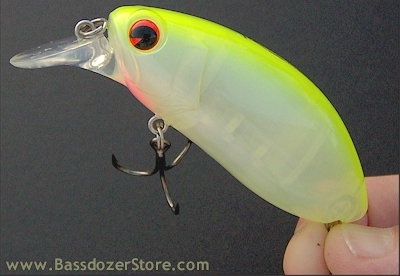
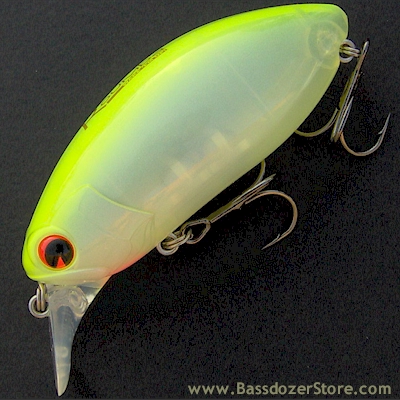
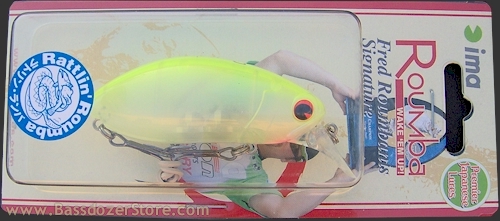
ima Rattlin' Roumba ~ Topwater Crankbait ~ Sour Candy
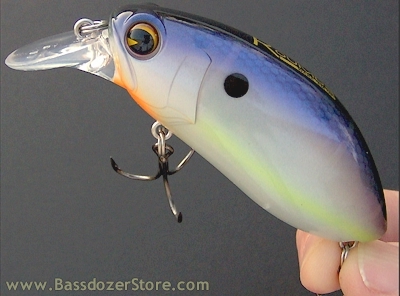
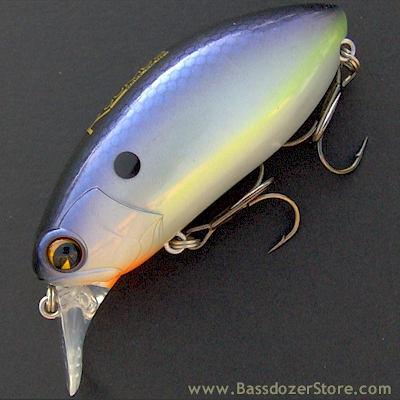

ima Rattlin' Roumba ~ Topwater Crankbait ~ Blue Shad
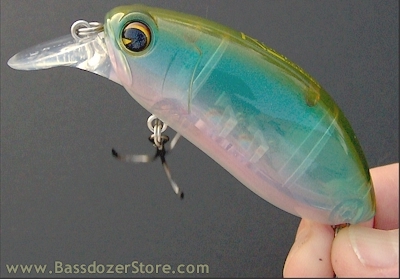
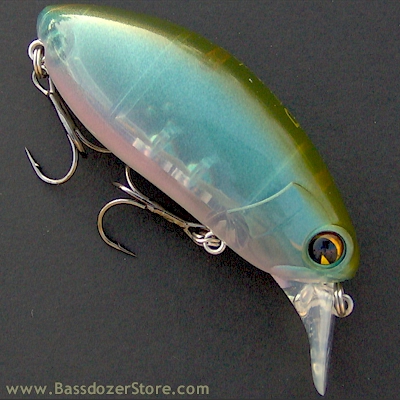
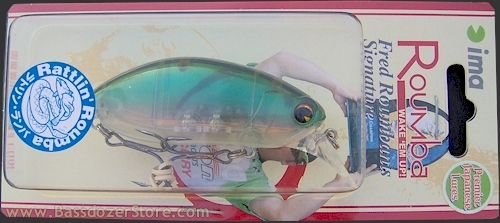
ima Rattlin' Roumba ~ Topwater Crankbait ~ Ghost Minnow
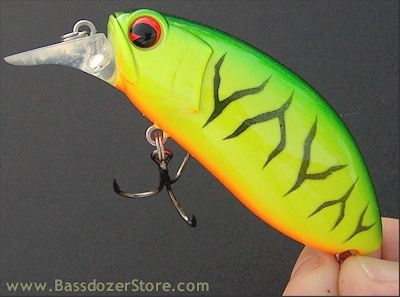

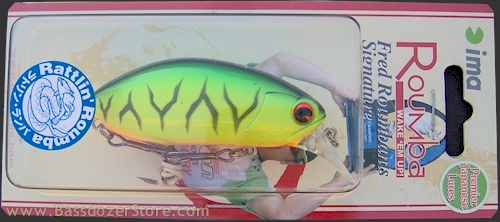
ima Rattlin' Roumba ~ Topwater Crankbait ~ Fire Tiger
Note that the Fire Tiger color has a bright orange belly.
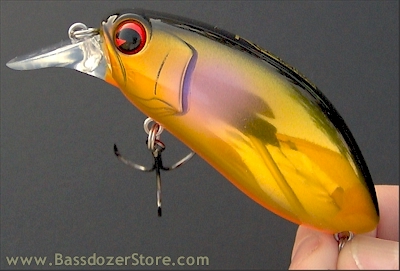
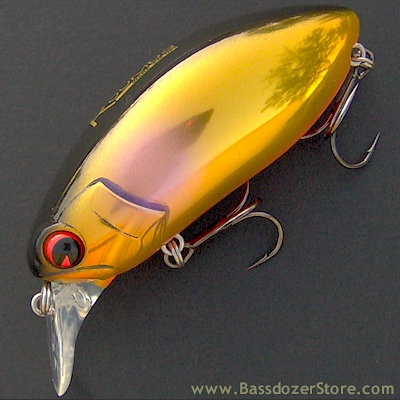
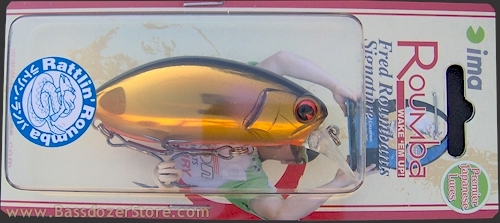
ima Rattlin' Roumba ~ Topwater Crankbait ~ Black Gold
Note that the Black Gold color has a bright orange belly.
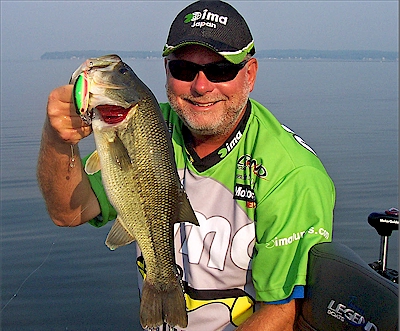
ima pro-staffer, Captain Karl Bunch shows a bold color named
‘Double Cheeseburger’ for added visibility - plus rattling
noise - in stained or muddy water.
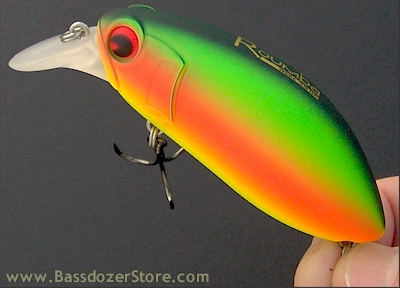
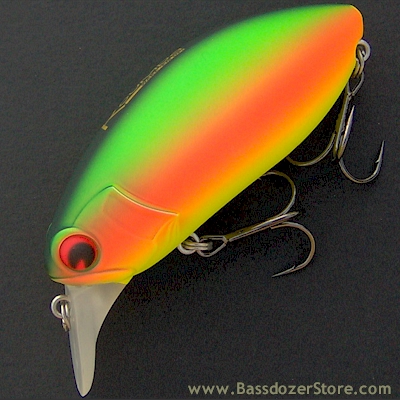
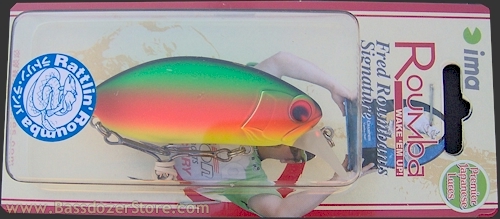
ima Rattlin' Roumba ~ Topwater Crankbait ~ Double Cheeseburger
ima Skimmer ~ Topwater Walking Bait
Model: ima Skimmer
Type: Floating/Walking
Weight: 7/16 oz (13g)
Length: 4-1/4" (110mm)
Factory Hooks: Two #4 Owner St-36
The new ima Skimmer is 4-1/2 inches long and weighs 7/16 oz
with two sticky-sharp premium #4 Owner trebles.
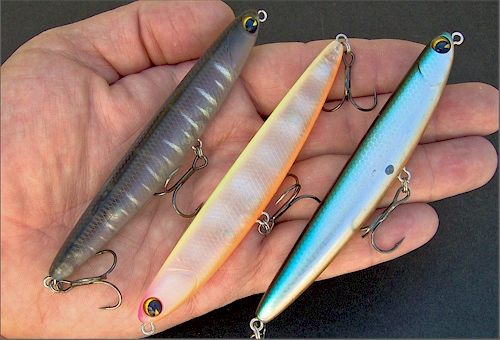
Slim Shape Appeal: The ima Skimmer is unique among hard
plastic topwater stickbaits in that the Skimmer has the slender
body shape of a 5" soft plastic stickbait. This slim profile
has proven to be one of the most appealing bass lure shapes ever.
There's a whole lot to be said simply for this slender profile
and silhouette, and the Skimmer is one of the only topwater
hardbaits that has it.
The ima Skimmer is hard plastic, but
it helps to think of it like a soft stickbait on steroids, one
that casts like an arrow, and cruises the surface like an
explosive missile.
It has a lively, light action. It knifes across the surface,
dancing, skating and swimming strongly like a svelte Olympic
swimmer in top condition. You may want to simply get a strong,
rhythmic side-to-side swimming motion going, where the Skimmer
uses its entire body length to swim, sculling across the top with
authority.
The Skimmer's movement is a skating, dancing, wriggling thing.
When done right, it practically comes alive, and that's an action
to concentrate on making - the movement and motion of the
Skimmer's slender swimming body versus the splash and confusion
of traditional stickbaits.
It's the strong swimming movement, not the splashing around,
that's key to the Skimmer's slim shape appeal.
ima USA pro-staffer Michael Murphy says: "A lot of
people put the Skimmer in the category of other walking baits. I
think the Skimmer is much different. It's kind of in its own
category. It looks like other walking baits, but it doesn't push
water, it cuts through the water. To see the design of this bait,
the body cross-section is a teardrop shape. And in fact the water
will flow over its back and will create a swirl right behind it
every time you jerk it, which a lot of baits won't do that. Other
walking baits will push water and splash but the Skimmer is one
that actually creates a swirl behind it. If you look at the
Skimmer on videos or when you are first working it, you'll
mistakenly think that fish are swirling at it - and that's what
it does, it creates the idea, the impression that there's a fish
trying to eat it. So a fish is more likely to become competitive
when it thinks another fish is there (but really is not there).
So it will see the surface swirl - and try to get the Skimmer
before another fish gets it. That's the beauty of this bait -
that boil, that swirl behind the Skimmer."
How to Bring Out the Best Action
Since the Skimmer is thinner, its action is cleaner and
crisper than bulkier baits. However, a lot of hand-to-eye
coordination is always required with any member of this class of
surface-walking lures. There's an art to pulling these puppets to
life on the end of your string. As always, practice makes
perfect.
The way to work the rod will vary a little depending on the
angle you cast it relative to the wind and based on the surface
condition (smooth, rippled, choppy and so on). You need to vary
the rod movement under different conditions based on what your
eye sees in terms of lure action. In terms of where to keep your
eyes, watch the head and eyes of the Skimmer.
Tune out the surface disturbance it's making. Don't even look
at that. Focus in on the bait's body movements, and you're going
to use what you see it doing in order to coordinate and adjust
your hand movements with the rod. There's a certain sweet spot
with the Skimmer that you'll recognize when you see it. The
side-to-side movement suddenly isn't mechanical any more. It
becomes more of a gasp or a flop or a jump to each side, and
there's a certain slo-mo 'hang time' that seems to occur that
visually lasts longer than it really is. Difficult to describe in
writing, but you'll recognize it when you see it on the water.
ima USA pro-staffer Michael Murphy says: "A guy
could get away with the same type rod for both the ima Skimmer
topwater surface walking bait and the ima Flit jerkbait. And the
way to work both is with the same walking motion. Keep the rod
tip below waist high and just work the rod with the short
twitching downward motion to where you can get both the Skimmer
and Flit to have side-to-side darting actions on every downward
rod stroke - known as 'walking the dog.' The only difference is,
of course, the Skimmer dances on the surface whereas the Flit
dives 6-8 feet, and as the water gets colder, add more pauses to
your retrieve with the Flit jerkbait. Another difference is I use
12 lb mono for the Skimmer topwater which floats. When you go to
fluorocarbon, it will sink and it will disrupt the action of the
Skimmer. With the Flit jerkbait, yes, you can get away with 12 lb
mono too - but I am a bigger fan of 10 lb test fluorocarbon which
sinks. So when I go to a jerkbait, I lean more toward
fluorocarbon just because of the sinking factor that helps me to
obtain that deeper range, thereby getting down there a little
closer to the fish."
Wild Boiling Action
The tail-weighting is another key to the Skimmer's appeal.
If you've seen mating dragonflies in early summer and the
female dipping the tip of its tail depositing egg after egg under
the surface, locked in synchronous flight with the male, the
graceful tail action of the Skimmer is not unlike that.
Another way to think of the stir caused by the Skimmer's tail
action is to compare it to one of those flat wood paint stirrer
sticks they give you with a gallon of wall paint - the tail has
the same stirring effect on the surface of the water.
A large part of the Skimmer's action is caused on the ending
note of each zig or zag as the tail-weighted back end of the ima
Skimmer dips and stirs the water causing a large boil to swell up
behind it.
Every time that the Skimmer zigs or zags left or right, the
final movement is the weighted tail stirs the surface into a
widening boil, and the Skimmer slips out barely ahead of the
boil, just like a desperate baitfish narrowly escaping a bass's
lunge. Each wide and sudden boil stirs the surface in an
instinctive and universal signal of a competitive feeding
situation.
Competitive Feeding Signals Call Bass in From Afar
The Skimmer's action then becomes a non-stop series of
ever-widening boils emanating behind it. It's like having a
school of surface-feeding bass on the scene, all taking their
best shot, boiling the surface behind the ima Skimmer's tail.
If there's ever anything that gets a non-committal bass to
bite, it is other bass feeding in front of it - and that's the
competitive feeding cue that the Skimmer's tail-stirring movement
sends out to every bass within range of sensing the
surface-feeding boils trailing out behind the Skimmer.
Stir Bass Into a Frenzy of Instant Excitement
Each wide and sudden boil stirring the surface is an
instinctive and universal signal of competitive feeding action
that calls bass in from far and wide to take advantage of the
feeding frenzy that's going on behind the Skimmer.
Getting the Hang of Up-and-Down Action
There's also what I call a 'delay hang' that can be gotten on
a slow retrieve. Once you master the side-to-side movement of the
Skimmer described above, then just delay so the tail hangs down
in between each zig and zag. By delay, you never quite stop the
action, but barely stall it long enough to get an up and down
bounce (the weighted tail dips down, the nose tips up) in between
each side sweep. So you get side-to-side flopping plus
up-and-down bouncing with this slower speed tactic. Think of an
incapacitated baitfish trying to flee forward, but instead
falling back. It's another one that's hard to describe in
writing, but you have the info now to practice it, and the fish
will let you know (and you'll recognize it yourself) when you get
the hang of this 'delay hang' tactic.
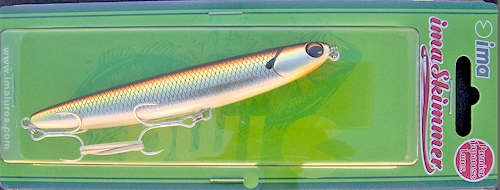
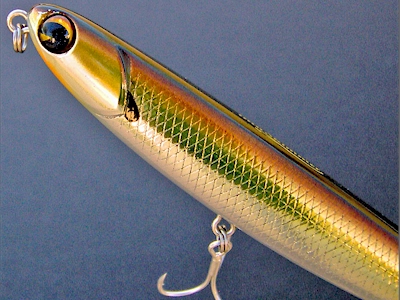
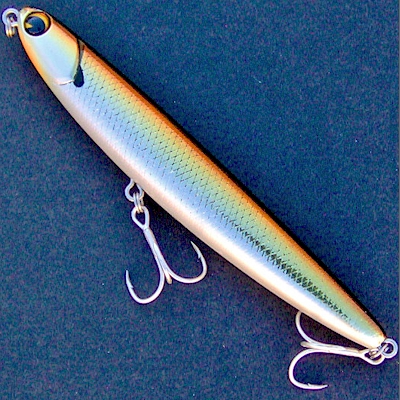
ima Skimmer ~ Topwater ~ Golden Shiner
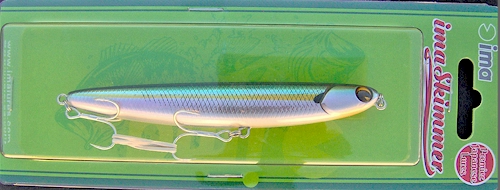
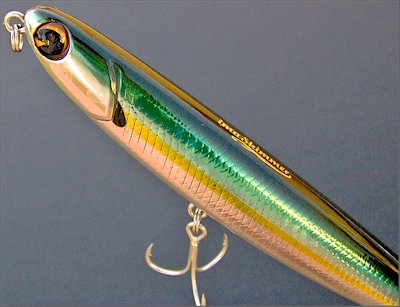
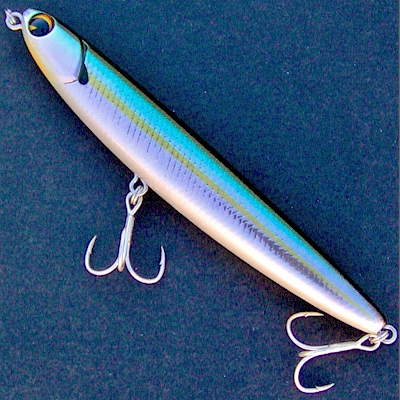
ima Skimmer ~ Topwater ~ American Shad
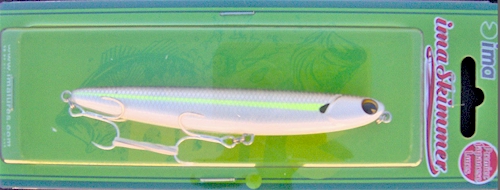
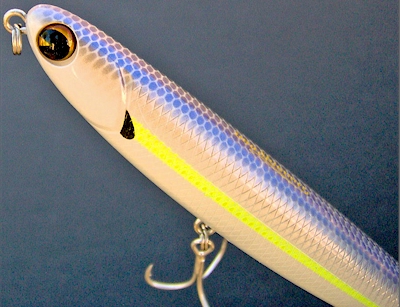
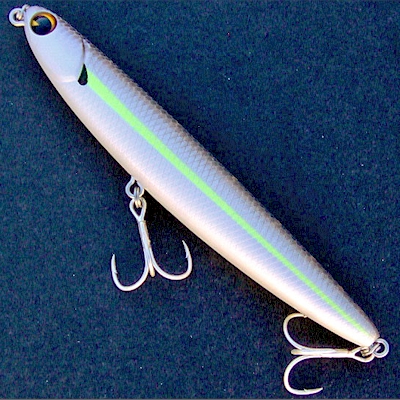
ima Skimmer ~ Topwater ~ Chartreuse Shad
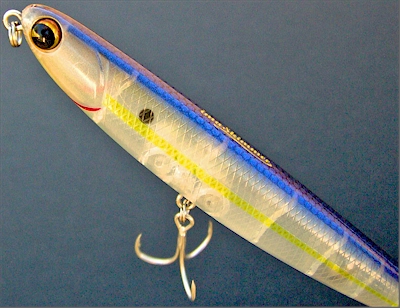
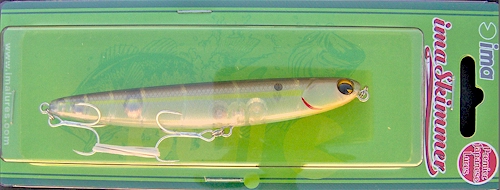
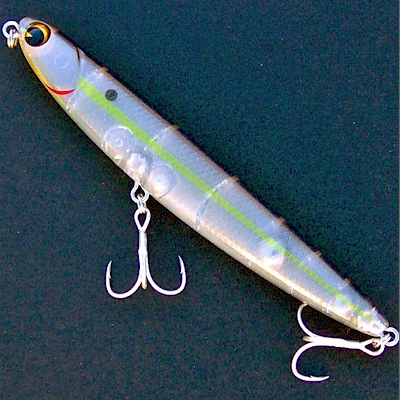
ima Skimmer ~ Topwater ~ Ghost Blue Back
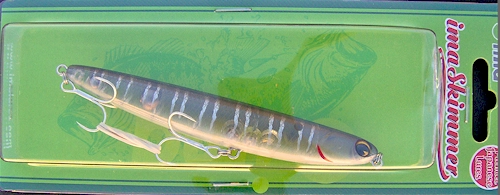
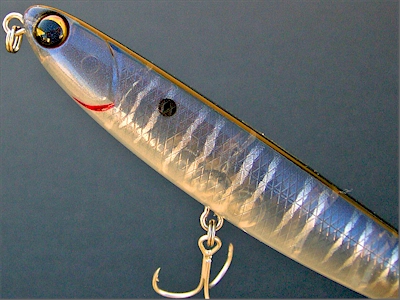
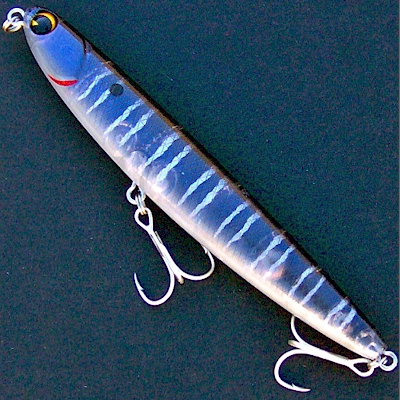
ima Skimmer ~ Topwater ~ Smoking Ghost Shad
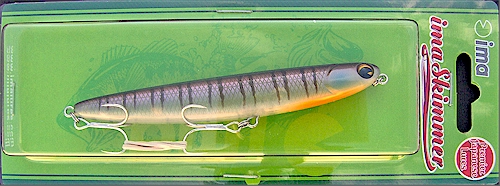
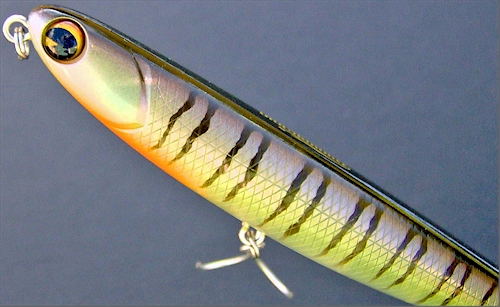

ima Skimmer ~ Topwater ~ Bluegill
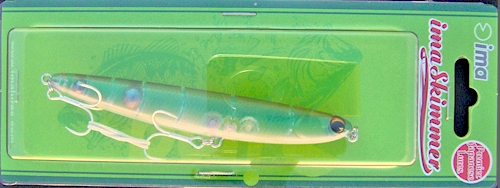
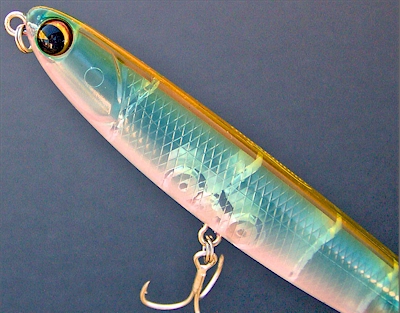
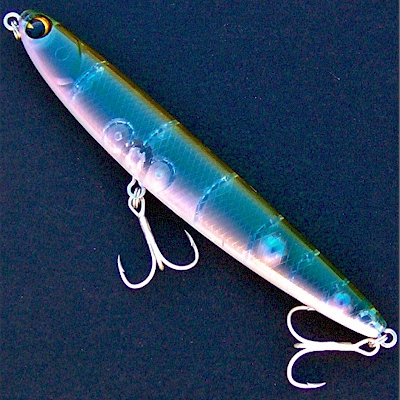
ima Skimmer ~ Topwater ~ Ghost Minnow
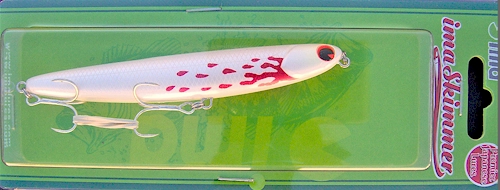
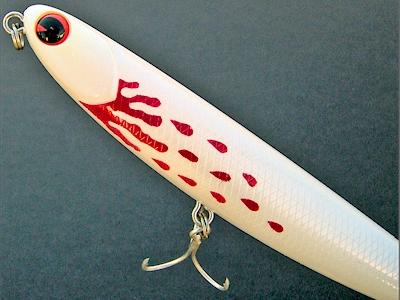

ima Skimmer ~ Topwater ~ Wounded Albino
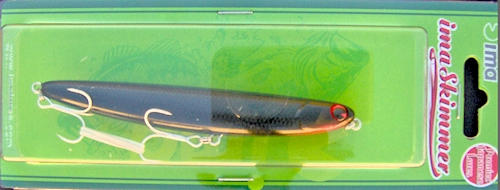

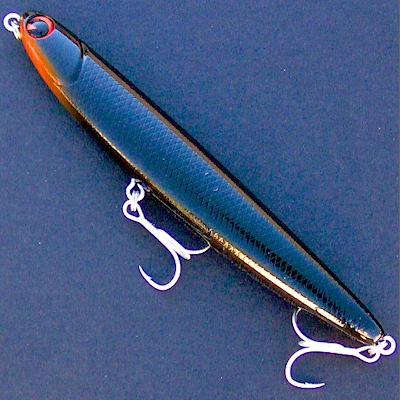
ima Skimmer ~ Topwater ~ Black Widow
Interview with Michael Murphy on Fishing the ima Flit 120
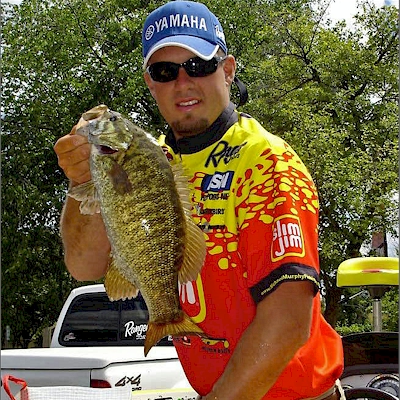 Michael
Murphy, designer of the Flit is interviewed, with a question and
answer session focused on fishing the Flit 120. Michael
Murphy, designer of the Flit is interviewed, with a question and
answer session focused on fishing the Flit 120.
Russ: To set the scene, what kind or
rod, make or model do you fish with the Flit? What reel? What
line?
Michael: The rod I like to use is a 6'9" stick. I stand
6'5" tall, and with the elevation of the boat bow above the
water, standing on the front deck, this rod is the perfect rod
for me to be able to point my rod tip straight down without
dragging in the water. I believe this is critical for ease of
use, to hold the rod straight down without hitting the water, but
this will be different for everyone. For a shorter person, it may
be a 6' rod. Overall, I like a medium/heavy action rod with some
good backbone but still a good amount of tip for casting, working
the lure and for playing a fish gingerly if it is barely hooked.
Russ: How do you recommend to attach
your line to the Flit? Why?
Michael: Directly to the split ring. Some like to use a clip
on their jerkbaits, hoping to get more action. This action is
already naturally build into the Flit without having to do this.
Adding a clip would most likely result in the front hook
continuously catching the line. A clip is not needed. Simply tie
direct to the split ring already provided on the lure. As far as
knots, any type of good cinch knot goes well with fluorocarbon,
except I do not like to use a Palomar with fluorocarbon since I
believe it increases the chances of knot failure, and I do like
to use fluorocarbon on my Flit.
Russ: How deep does the Flit dive?
Are there any certain types of cover or structure or something
else specific that's an ideal situation for the Flit due to its
working depth?
Michael: Many jerkbaits are first designed on looks (eye
appeal) and then the bill is constructed to achieve action and
depth. Since the Flit is designed based on the idea of matching
the hatch and to mimic the cadence of baitfish, specifically of
the herring family (i.e., blueback herring, gizzard shad and
threadfin), the action is already built into the Flit body. The
bill is there to only achieve depth, not impart action. If you
would like it to achieve its maximum depth, point your rod tip
down toward the water to obtain 8 feet of depth on 8 lb
fluorocarbon or 6 feet of depth on 10 lb fluorocarbon. You may
change the position of your rod tip to make it run shallower.
With your rod tip pointing directly up at an eleven o'clock
position, you can make it walk just beneath the surface. The Flit
very effective, whether used to fish deep on bluff walls or
shallow just under docks.
Russ: Is there anything you can do in
terms of rod, line or retrieve or any other bait adjustment that
lets you reach different depths? Is there anything that can make
the difference of getting the Flit a couple of feet deeper or
shallower?
Michael: As mentioned above. line diameter and also line type
do make a difference. The general idea using the ima Flit
jerkbait is the smaller the line diameter the deeper the bait
will go, simply due to less line drag. However, with the Flit,
the exception to this would be at rest. Mono floats and fluoro
sinks. You could use this to your advantage to behave differently
or run at different depths dependent on specific situations.
Again, this will vary among line brands and types. No two lines
are exactly the same.
Russ: Sometimes a bait gets
categorized as a smallmouth killer or a spotted bass killer, or a
largemouth magnet. Do you think the Flit has a special or higher
appeal to smallmouth, spotted bass or largemouth? Why or why not?
Michael: I couldn't tell you. The Flit catches all three bass
species equally and all very effectively. I think you can't tag
this type of reputation on the Flit, since all three species feed
on members of the herring family, which makes them all equally
vulnerable. I can tell you, with all three bass species there are
no differences. They all eat it most excellently. If anything I
would call it the "anything that swims and feeds on baitfish
magnet" because it is not just with bass, but it could be
redfish, pike, perch, gar, you name it. I have caught practically
everything on the Flit so far.
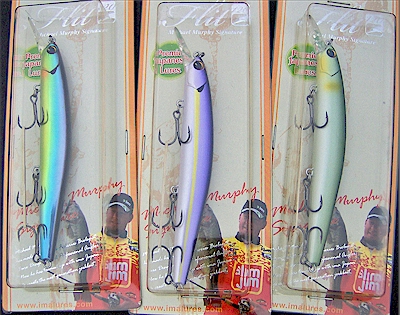
Murphy has designed the ima Flit 120 jerkbait.
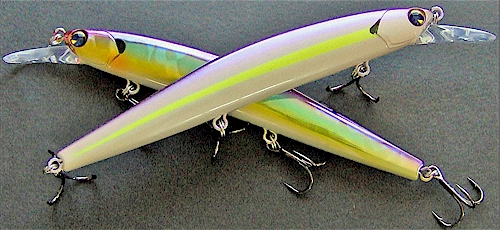
Russ: Some anglers mention having a
good jerkbait bite first thing in the morning, and then have it
fade out and die on them by mid-morning. Is that something you've
seen about the Flit bite? Is the Flit bite similar to what some
have experienced with an early morning topwater bite, that it's
usually good at first light, and shuts down once the sun hits the
water? Or is there anything you can do or any conditions or
factors that make for a good Flit bite all day (or as long as
those factors remain present)?
Michael: No. It is not like that. As the sun comes up, I start
to chase shadow lines. It may be the shadow line off of a bridge,
dock, trees, bluffs, etc. Seems like bass will just pull tight to
these shaded areas. It is not just with jerkbaits, I would say
this applies with all lures under these early morning conditions
and it is merely the natural behavior of how bass act. I say
this, because I would never say a topwater bite will completely
shut down. Instead, it will just change. I have had some of my
best topwater days on Lake Lanier over 30 feet of water on clear
bluebird days catching both spotted bass and largemouth. I think
the shutting down of any bite or that sudden "lock jaw"
is nothing more than a myth. Strike zones and the willingness to
commit may become smaller, or how fish may hold to structure may
change under changing conditions. However, at the end of the day.
it is all basic behavior and simply what makes the best sense for
how a bass can ambush its prey. Bass are always eating, it is
just a matter of how or where. I have never seen a tournament
where someone did not catch something. So I am not a big believer
in a bite shutting down because the fish were not eating. The
bite just changes or shifts. As anglers, we may lose the bite,
but it's still going on somewhere.
Russ: What would you say is the
biggest error you see anglers make with jerkbaits?
Michael: Certainly it's stereotyping the technique. The belief
that it is only good for spring and for post frontal situations.
They (jerkbaits) are good all the time.
Russ: Overall, what action are you
trying to create with a jerkbait, and with the Flit specifically?
What impression are you trying to make on the bass with the Flit?
Is it supposed to be an injured or disoriented baitfish - or a
perfectly normal baitfish movement?
Michael: Both. You can make it look disoriented or like a
normal baitfish. Whatever condition or mood the bass may be in,
you can match it. The Flit can be fished with random jerk and
pause techniques, or with a consistent walking side to side
motion. It is based on the concept like a Zoom Fluke or other
soft jerkbait, or a topwater like a Super Spook. Both the Fluke
and Spook have very effective actions. Now imagine being able to
do that on a bigger scale, better and where you are more easily
able to catch the fish that are just slapping at it and not
really willing to commit. You'll hook a good percentage of these
non-committal fish with a jerkbait.
Russ: With the jerk component of the
action you create, do you vary the jerk for different seasons or
different reasons?
Michael: Yes, the colder or less active the fish are, the
tighter the walk or the shorter the jerks I will use with a
longer pause. The warmer or more active the fish are, the harder
I will lay into the jerks and the more frequent and consistent I
will work the lure with less pauses.
Russ: With the pause component of the
action you create, do you vary the pause for different seasons or
different reasons?
Michael: Yes, as mentioned above.
Russ: Which is the most important
part, the jerk or the pause?
Michael: It depends on the time of the year. Both are equally
important. This goes back to the previous two questions.
Russ: What other elements are there
to the action? Is the reeling an important element? How fast or
how far you reel, do you vary that? Any other elements to the
action except the jerk, the pause, the reeling?
Michael: I typically reel a quarter to a half a turn per jerk.
With this type of technique, the reel is nothing more than a tool
to hold the line, and a good drag and high speed retrieve when
fighting a fish.
The most important elements to working a jerkbait are the rod
action and how you work the rod. In addition, your attention to
details of what happens to the jerkbait on different jerks and
rod angles, and tying all this together to discover what is most
persuasive action to the bass on any given day.
Russ: Do you look to develop a
cadence or Flit "action" for the day? That is, once you
catch a few on a certain sequence of jerks and pauses, do you
find all your fish going for that same sequence of
jerking-pausing? Or do you catch fish on a diversity of cadences
during the same day?
Michael: Absolutely a cadence or "rod action
pattern" materializes many days. This goes right along with
my previous answer and the paying attention to details that spell
what is the fish's preference for the day or for the situation at
hand.
Russ: At what point do most strikes
occur? What induces the strike - the jerk, the pause, the reeling
in or what?
Michael: The pause, over 90% of the time.
Russ: How would you say that jerking,
pausing and reeling in a jerkbait differs from popping, pausing
and reeling in a topwater popper? Is it essentially the same
action for a popper and a jerkbait? If not, what are the
differences between working a topwater popper and working a
jerkbait (except of course you can see the popper)?
Michael: Yes, they're both pretty much the same. Especially in
the aspect that there are about as many different and effective
ways to work a popper as there are to work a jerkbait
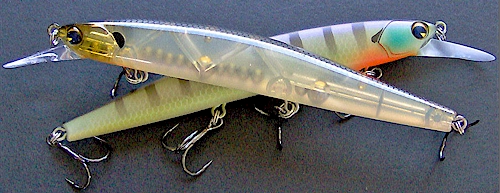
Russ: What if you suddenly see a bass
following the Flit as it gets near the boat (or shore)? What do
you do to convert those followers into biters? How do you get
them to commit and whack it? Or if they break off the chase and
drift away, how do you get them to come back and strike on the
next cast?
Michael: There is a technique that I discovered with the Flit,
and it is the only jerkbait I have found you can do it with,
because it has such tight walking action. With the right among of
slack before the jerk and immediately after allowing the bait to
glide, you can make the Flit literally do a 180 degree
about-face. If the fish is trailing close enough and not willing
to commit, you can make it bite out of mere reaction with this
180 degree turn-around maneuver. Bass don't have hands to swat,
they use their mouth, and this results in a catch. This does take
practice, but it is one of the absolute coolest thing you will
ever experience. I did it on Lake Murray with a 5 lb 8 oz bass,
it was unbelievable!! I have done it with many other fish, but
the 5 lb 8 ouncer was the coolest because it followed the Flit
the first cast and peeled off, and then I was able to get it to
track it again and I did this 180 on it. It was so funny because
it was apparent it hit out of sheer reaction to the 180
turn-around. This bass didn't even know what to expect or what
happened. It just bit, but it didn't even fight. That was the
down side. It was pretty lethargic. At the same time, it was
pretty funny.
Russ: How come so many jerkbait bass
are partially hooked on the outside of the mouth? Some have
suggested that the bass is slapping the lure's tail or pushing
against the lure's tail so it can turn the long jerkbait 180 and
swallow it head-first. What do you think of that?
Michael: I used to have fish (two spotted bass, a largemouth,
and two crappie) in an aquarium. I would feed them gold fish. If
they were hungry and/or competitive, they would eat the gold fish
any way they could get them down, sideways, tail first, head
first, it didn't matter. As the competition abated and/or they
were getting full, they were more selective and would go for the
goldfish head first. However, doing this, is a little harder for
them to do. So they would ambush them from the side, battering
them, with scales falling off, until the prey moved slow enough
and were an easy enough target for them to successfully eat head
first. With jerkbaits, I believe that may be what they are doing
at times, hitting the jerkbait first as to kill or stun it to
make it easier to eat. In many cases they will go through this
motion with their mouth closed or mostly closed as to not eat it,
just incapacitate it first. With a jerkbait, the hooks may
naturally end up on the outside of the mouth.
Another explanation is far simpler. A fish swims up to inspect
the bait and simply noses it, much like it would nose a jig,
worm, or crayfish on the bottom of the lake out of curiosity, but
with a jerkbait, because of the sticky-sharp trebles and the
jerking motion of how the lure is worked, the nosy fish may get
stuck around its mouth or side of the fish's head, resulting in a
catch. Such fish certainly are not intentionally being snagged,
but depending on the particular state regulations or tournament
rules, this may or may not be deemed a keepable catch.
Russ: Before we conclude our
interview, Michael, are there any other points you'd like to
mention about jerkbaits or fishing with the Flit?
Michael: I think we pretty much nailed many of the most
important questions. I can't think of anything else to add. Thank
you for asking.
Model: ima Flit 120
Body Length: 4-3/4" inches (120 cm), not counting the lip
Weight: 1/2 ounce (15 gr.)
Depth: Floats at rest. Dives 6-8 feet. Suspends when paused.
Rattling.
Hooks: #6 Owner black nickel hooks
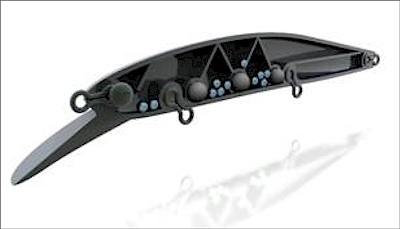


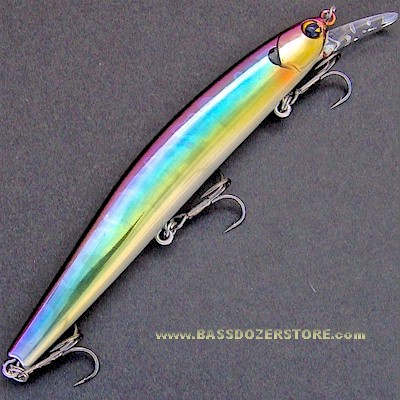
Ima Flit 120 ~ Jerkbait ~ American Shad
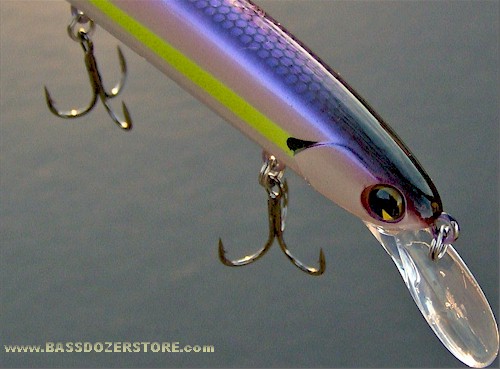
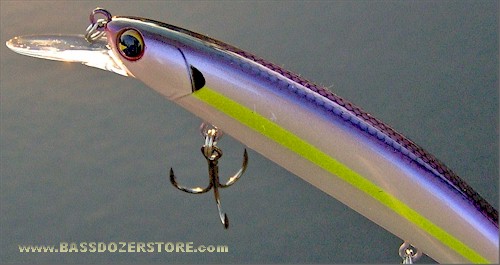
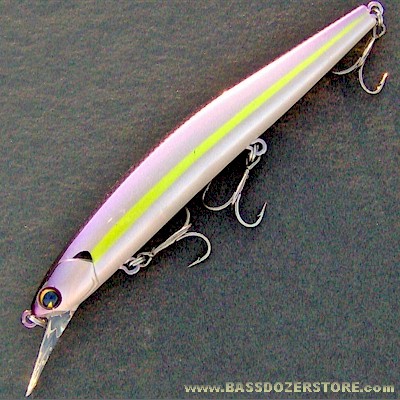
Ima Flit 120 ~ Jerkbait ~ Chartreuse Shad

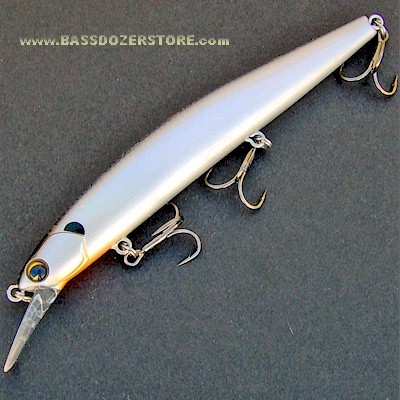
Ima Flit 120 ~ Jerkbait ~ Tennessee Shad

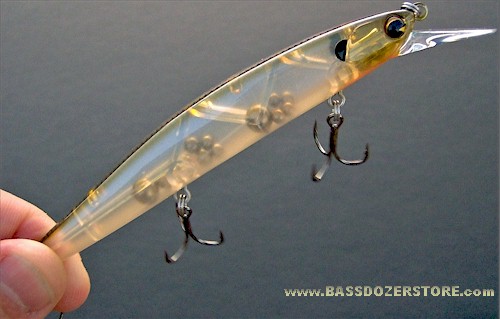
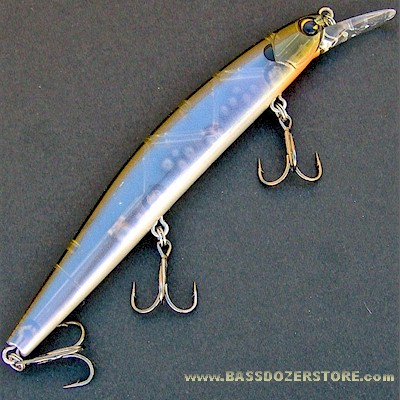
Ima Flit 120 ~ Jerkbait ~ Ghost Minnow
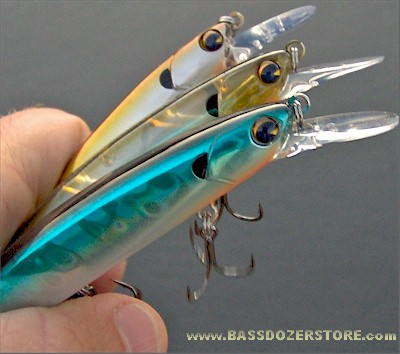

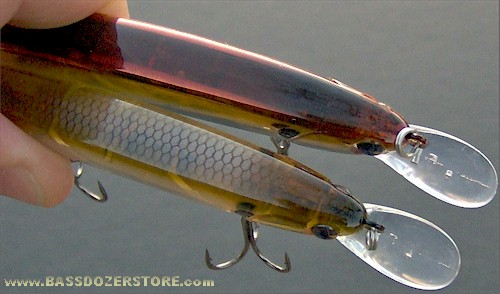
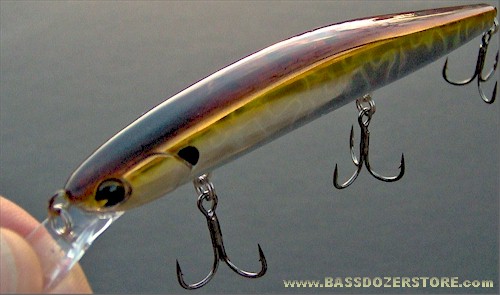

Ima Flit 120 ~ Jerkbait ~ Brown Flash

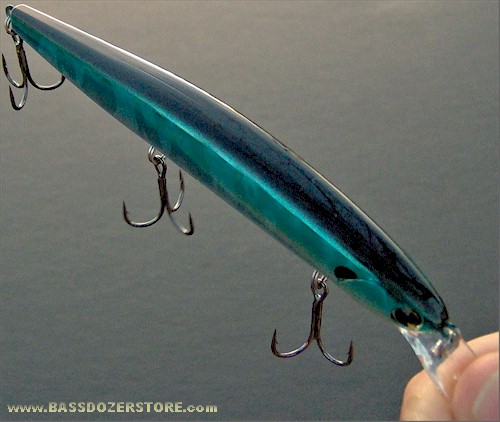
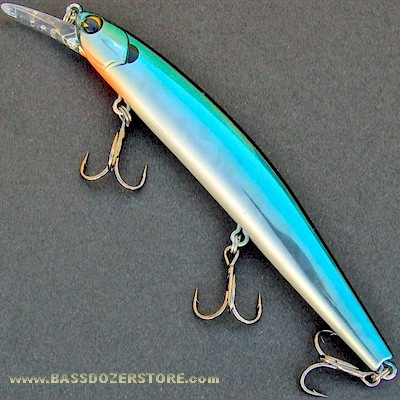
Ima Flit 120 ~ Jerkbait ~ Blue Shad


Ima Flit 120 ~ Jerkbait ~ Matte Bluegill
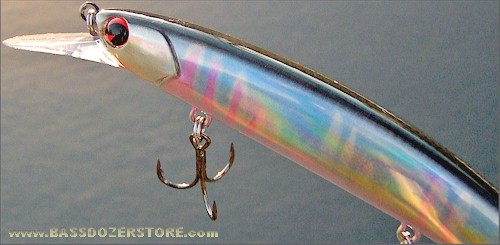
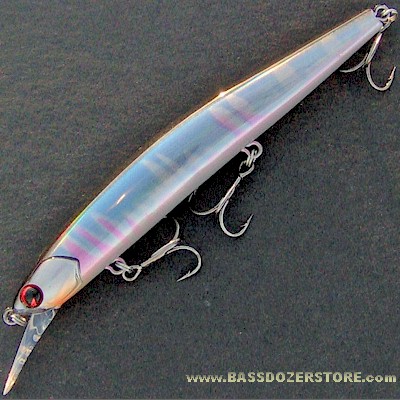
Ima Flit 120 ~ Jerkbait ~ Misty Shad
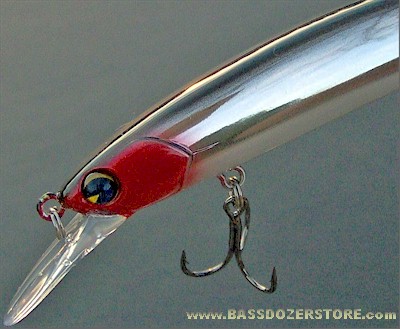

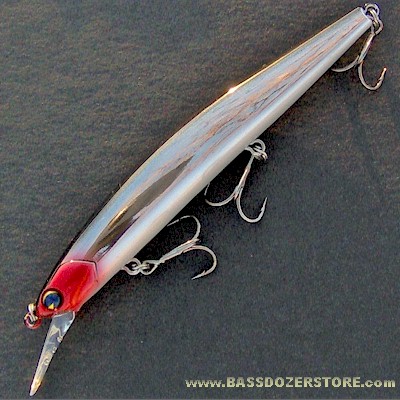
Ima Flit 120 ~ Jerkbait ~ Silver Flash
ima Shaker ~ Flat-Sided Crankbait
 ima's
USA pro-staffer Bill Smith designed the ima Shaker. It is a
small, flat-sided, shallow-diving crankbait with a thin
computer board lip. At 2-3/4 inches long, the Shaker weighs 3/8
oz and runs 3 to 5 feet deep. With its internal weight transfer
system, the Shaker let's one reach unprecedented casting
distances with a crankbait of this kind. ima's
USA pro-staffer Bill Smith designed the ima Shaker. It is a
small, flat-sided, shallow-diving crankbait with a thin
computer board lip. At 2-3/4 inches long, the Shaker weighs 3/8
oz and runs 3 to 5 feet deep. With its internal weight transfer
system, the Shaker let's one reach unprecedented casting
distances with a crankbait of this kind.
Bill designed the ima Shaker to improve upon and replace the
flat-sided balsa crankbaits that are regional favorites in his
neck of the woods, the southeast USA. Smith grew up fishing balsa
crankbaits for over twenty years, and he know them well. He knows
what are balsa's merits as well as balsa's weaknesses.
Since the Shaker is the latest improvement upon and
replacement for balsa, it is fitting to first share a few words
with you about the Shaker's predecessors - balsa crankbaits. So
first, here is a bit of the interesting history of balsa
cranks...
A Little Background on Balsa Crankbaits
Originally, going back over forty years, the Big O is one of
the first milestones. The original Big O they say was whittled by
hand out of balsa wood by Fred Young of Oak Ridge, Tennessee in
the late 1960's - and they say that is the start of balsa
crankbaits for bass in the USA. Mr. Young was not the only one
whittling balsa crankbaits in the region 40 years ago, but the
Big O is the one to achieve some sort of national fame and
lasting historical significance. It really only did that because
it was reproduced in hard plastic during the early 1970's by
Cotton Cordell and quickly sold by the millions. But my point is
that as far back as 40 years ago, hand-carved balsa crankbaits
were popular and prized baits across the south even then.
Other early and legendary names in balsa crankbaits include
Jim Bagley, Lee Sisson and certainly Rapala. These were on the
scene since the early to mid-1970's. Today, these names still
have national and worldwide recognition. When it comes to balsa
crankbaits, many bass anglers may be familiar with those names.
What's not so well-known outside the southeast USA region is
the ongoing refinement of locally hand-crafted balsa crankbaits
by lure builders across the region and states of Virginia, West
Virginia, Tennessee, Kentucky, Alabama, Georgia, Indiana, Ohio,
Illinois and parts thereabouts. This is all considered balsa
crankbait country.
Especially within the last twenty years or so (since the
mid-1980's), many of the locally-produced balsa crankbaits used
across this region have been refined to a fine art. This is
woodworking and furniture-manufacturing country, where
whittling's a pastime and a handful of guys here have the modern
toolshops and wherewithal to produce high quality balsa
crankbaits.
Bill Smith says, "There was an old gentlemen from whom I
remember my Dad would buy hand-crafted wood topwater lures. This
fellow worked in a furniture factory, and made lures in his spare
time. This old gentleman did not even fish, but he paid close
attention to the constant feedback from the anglers who were his
customers, like my Dad. He'd make the changes they suggested to
him, thereby improving his topwater products. Both the anglers
and the artisan took a sense of pride from this. Over time, he
gained quite a local reputation and following for well-made,
fish-catching topwater baits. Now take someone with that
woodworking skill and love, with a little tool shop, who takes
pride in their work and also likes to fish, and that's what's
been happening for the past twenty years in this part of the
country with regionally-produced balsa crankbaits."
You can think of what's gone on in the Southeast with balsa
baits as being similar to what's gone on with swimbaits on the
west coast. For the longest time, swimbaits were a local
phenomena, designed, developed, locally-made and used on the west
coast as an effective way to catch the bass there. Of course, we
see today that swimbaits work everywhere, not just California.
Likewise, balsa baits made in and used across the southeast,
have been local favorites for the longest time. But as we've
found with swimbaits, these balsa crankbaits (and now the ima
Shaker) will also work everywhere, not just in the local region,
but everywhere across the USA.
As a Bassmaster Elite Series pro, Smith has fished across the
country, 95% of the places he has been from coast to coast and
border to border, these balsa crankbaits (and now the ima Shaker)
have worked for Bill.
"I can tell you that there isn't a Bassmaster Elite pro
who I know who doesn't have a box full of flat-sided, hand-made
custom balsa crankbaits on his boat, ready to use at every event
across the country. These are baits that are hard to get, that
have taken years for many of the pros to amass the boxfuls
they've got. Every pro has them and knows that at any time or any
place, flat-sided balsa crankbaits can prove effective,"
says Bill.
Introducing the ima Shaker
Now that we've gotten you interested to try balsa baits, you
need to know that the new ima Shaker is an improvement upon and
replacement for a certain kind of balsa bait - the flat-sided
crankbait.
"The flat-sided balsa bait gained a following in the
Tennessee/Alabama market years ago. It's real strong on the
Tennessee River chain, and also on Ohio River system, where they
seriously refined the trend of the smaller flat-sided baits to
imitate smaller shad so prevalent there. Over time, this
flat-sided crank spread throughout the southeast market,"
says Bill Smith.
The ima Shaker is the very latest flat-sided crank that
matches this most common smaller size of shad.
The Shaker has a very lifelike baitfish appearance. With the
flat sides, the Shaker imitates more of a shad than the typical
fat, bulbous, round-bodied crankbait. The flat-sided Shaker looks
like a shad and has a more realistic profile. Yet it still has
the characteristic wide wobble of a balsa bait.
However, the ima Shaker is not balsa. The Shaker is a new
injection-molded hard plastic bait with a computer board lip. The
Shaker is designed to have all the merits but none of the
weaknesses of balsa.
Some of the big disadvantages of balsa crankbaits versus the
ima Shaker are:
| Good
Quality Balsa Crankbaits |
Ima
Shaker |
| They can't take but
one good hit on a rock or a log or the diving bill may loosen
from the surrounding softer balsa lip slot. |
The main factor is
durability, the lip stays in. The lip slot is molded (not
hand-cut) with a very tight tolerance that helps fortify and
secure the computer board lip within the surrounding,
tightly-fitting hard plastic. |
| The
line tie eye and hook hangers are screwed-in, slots for lips and
belly weights are drilled and then glued by hand, not always
perfectly. |
The
component parts, hangers, eyes, weighting system and lip are
precisely fitted into injected-molded bodies, with little to no
possibility of being off. |
| The hook hangers or
front line tie eye can loosen up under a little too much pressure
or pull right out of balsa. |
The hook hanger and
line tie are molded in "figure-eight" stainless wire.
Not likely to ever pull out under normal fishing conditions. |
| A
balsa body will often break toward the thinner tail section,
especially if a fish is hooked on the tail treble only. |
The
hard plastic body is not likely to ever break under normal
fishing conditions. |
| Balsa is a light wood
and especially with the flat sides, hard to cast. It often
waffles in the air like a potato chip, falling all too short,
causing nasty line snarls or backlashes. |
The Shaker features
an internal weight transfer system allowing the bait to fly
incredibly far distances on the cast with greater accuracy and
line control. |
| No
two are ever quite the same, due to the natural inconsistencies
of each piece of wood, plus the line tie, hangers, belly weights,
lips are not always consistent. For any 12 balsa baits, you tend
to find 2-3 are truly good and will catch most of your fish.
Another 6-8 may only ever be average catchers, and 2-3 may never
work well. |
ima
has eliminated this problem of inconsistent baits. Every Shaker
will run true straight out of the package. The buoyancy rate and
action will be the same each time. We took a long time to get the
ima Shaker perfect, based on decades of experience using balsa.
We made the prototype Shaker the best we could - and
precision injection-molding makes it consistent for every single
bait. |
| The
good ones are hand-made and always hard to get. Often you have to
be a pro or know the lure builder to have any chance. If you
place an order today, the waiting list may take from one to two
years for some. |
The
ima Shaker is readily available across North America. Anyone can
get the Shaker, a lure similar to the hard-to-get flat-sided
balsa cranks that most of the top pros have a boxful. |
| Because
they are so fragile and hard-to-get, most anglers avoid using
their best balsa cranks in heavy cover, the very places that fish
favor most. |
The
ima Shaker can be fished through all difficult cover - around
docks, rocks, stumps - that would utterly destroy a balsa
crankbait. The bodies won't break or chip and loose chunks (like
balsa does) when they flare off of wood or a rock. |
| Good
quality balsa cranks are expensive. |
The
Shaker costs less than good hand-made balsa crankbaits. The
Shaker is a GREAT BUY when you think that you are spending more
for a hand-made balsa bait that you don't know will run true and
balsa has the potential of getting destroyed quickly. |
As you can see above, the Shaker is designed to imitate a
balsa bait, and improve on it. The advantages of the Shaker over
balsa are many - more durable, lasts longer and with its internal
weight transfer system, is easier and more accurate to cast than
balsa.
Castability
Because a flat-sided balsa crank is such a poor casting lure,
a lot of time you can only use one with 6-8 pound spinning gear
to have any hope of casting a decent distance. Even then, you are
probably talking about a 40 foot cast with a balsa crank on light
line spinning gear versus a 60 foot cast with the ima Shaker on
10-15 pound baitcasting gear. That heavier grade of baitcasting
gear could pull a balsa crank apart like it was cotton candy - if
you could even cast a balsa bait on such gear (you really can't).
So you're comparing 60 feet with the Shaker on a 10-15 pound
baitcaster versus 40 feet for balsa on 6-8 lb spinning gear.
That's 20 feet longer that the Shaker is in the water,
attracting fish, on every cast. That's significant and equates to
more fish caught due to the Shaker staying longer in the strike
zone.
So not only is the Shaker more durable, able to withstand the
force of heavier tackle, but also casts much further (and
accurately) and can be fished in dense cover that fish love.
Color Choices
The hard-plastic injection-molded nature of the ima Shaker is
a radical new departure from balsa baits - but the finishes and
color patterns are not.
The ima Shaker finishes make them look like they're balsa
cranks. When painted and finished, it's hard to tell at first
whether the Shaker is plastic or wood.
ima and Bill Smith have tried to stay true to the well-known
regional color patterns used on hand-made balsa cranks across the
southeast, plus they've stayed with the unique names used for
these regional color patterns.
The guys in the southeast who throw balsa cranks will be
familiar with these names and colors. They are derived from
favorite colors of parochial balsa baits - like the color
Plemmons is one of the most famous. That has been around for
ages, and everyone in the region knows what color it is just from
the name - Plemmons.
Besides Plemmons, Coach Dog and Dolphin are probably the three
most famous colors in the region.
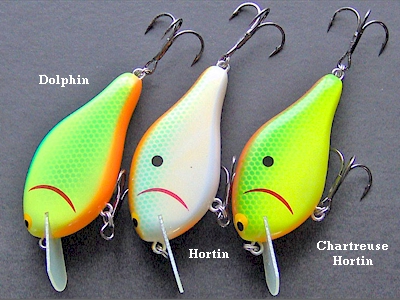
Another unique color is named Hortin as well as Chartreuse
Hortin. These are names that have never changed for ages. Smith
felt a need to make the names and colors of the ima Shaker very
familiar to the guys in the southeast in balsa bait country. At
the same time, the names and colors are going to be new and will
take a little getting used to by anglers in other parts of the
country. But don't worry, you will get familiar with these colors
quickly. When you catch a few fish on them, they'll become your
favorites too.
Another color is Lime Coach Dog. If you don't know what coach
dog refers to, it is a Dalmatian. They were trained in days of
yore to run alongside and accompany carriages or coaches on the
road. So the Coach Dog lure color has Dalmatian spots all over
it.

One thing that Lime Coach Dog, Matte Bluegill and Coach Dog
(shown above) have in common is that they are early spring time
colors. Bill Smith feels why they work best then is that they
really imitate bluegill that are the prevalent forage up shallow
then. Honestly, Smith could never figure out any rhyme nor reason
why, but Coach Dog always seems to work better when the bass
first come up shallow in the spring whereas Lime Coach Dog tends
to hold up and lasts a little longer through the latter part of
spring. Matte bluegill is always effective as long as small
bluegill abound.

Plemmons and Rootbeer (shown above). These are two solid shad
colors. They excel whenever there are lots of shad around. Now,
root beer always seems to work fished right in the thick of the
shad. You may wonder about that, because it does not resemble a
shad color. In its case, you don't try to match the hatch. You
try to stick out from the rest, and bass hone right in on it.
Some of the other colors - Black Chartreuse for instance, are
old familiar standbys. Colors such as White Shad and Alabama
Shad, are simply solid, universal shad colors. Don't leave home
without them.
We talked about color choices above being based on certain
seasons or prevalent baitfish. Color choice can also be based on
water clarity:
- Clear water. Matte
Bluegill, Hortin and Rootbeer are reliable.
- Dirty water. Try Dolphin,
Black Chartreuse and Coach Dog. There is a little bit of rattle
sound which helps. Fish pick up on that little noise, plus the
crankbait's vibration can call them in from a decent distance in
dirty water.
- Stained water. The most
productive water color, better than either clear or dirty water.
For shallow-running flat-sided crankbaits, I always like to have
some stain. A wide variety of colors will work in stained water
depending on the season, the prevalent bait and other factors.
- Plemmons. The favorite
color of many because Plemmons works in any water color. So
always give Plemmons a try.
Where and When to Use the ima Shaker
The ima Shaker is a shallow diver, running 3 to 5 feet deep.
Therefore, where and when it works best is in shallow water, no
more than eight feet deep.
Simply, where you have bass in a water depth of five foot
(less than 8 foot), that's the strike zone within which the
Shaker is going to work.
However, when shad are up on the surface away from the bank,
over relatively deep water, the wide wobble of the Shaker
swimming through the shad schools will break up the shad, cause
the shad to flush. This disperses the shad balls enough to get
bass to notice the Shaker in the middle causing the disturbance -
and that can provoke a strike. This little trick can work when
bass are present, but not very aggressive on topwater lures. The
fact that the Shaker's a few feet under the surface, and busting
up the shad schools as it comes through them can prove effective.
It almost turns on a bass feeding frenzy for a few seconds during
which the shad balls scatter apart, the Shaker gets revealed in
the middle, and bass hit it.
- Spring and Fall. Bass are
most often up in shallow water in the spring and fall. So the
Shaker will work anywhere there's shallow water during spring and
fall. Especially in stained or muddy water, fish like to stay up
shallow for a longer part of the season.
You can really hit rocks, stumps, shallow structure and not get
hung up. Usually, when a crankbait has a real wide wobble, the
hooks swing out from side to side and grab everything - but
that's not the case with the ima Shaker. You can go right through
tree tops, stump fields and rock jumbles, and unless the bait
gets wedged, just give a little slack, and it's going to float up
and over most anything down there.
- Summer. Once you get into
the summer season, you need to dissect your lake or reservoir
into the main lake body versus the side creeks, the upper river
arms or tributary type areas.
In the main lake body or big basin type areas, bass tend to move
off the banks and they occupy deeper water beyond the effective
range of a shallow-diving crankbait in summer.
However, there are always some bass shallow all through the
summer, especially if you go up into a river arm, the back end of
a creek, an inflow end of a reservoir, or anywhere with a current
situation, you can produce shallow bass on the Shaker throughout
the summer.
On reservoirs where water is routinely drawn to generate
electricity or for whatever purpose they pull water, bass tend to
move from deep havens to nearby shallow areas for the duration
that moving water flows through those shallows. So even the main
lake, when they pull water during the summer months, can have
shallow bass willing to belt the Shaker at those times.
- Winter. As in summer,
many bass tend to pull into deeper areas off the banks in winter,
and in the colder months of the year, bass tend to want a
tight-wobbling crankbait anyway. The Shaker is more
wide-wobbling.
For those who live up north in smallmouth country or wherever
one bass species is more prevalent, you'll be glad to know the
Shaker appeals equally to all three species of bass, largemouth,
smallmouth and spotted bass.
"The swimming action of the ima Shaker is very unique. It
took a lot of time until I got the action perfect. There's just
no way I can truly describe how well this crankbait wiggles
through the water. You really need to get one and go watch it
swim to believe it. Once you see that, you'll want to use the
Shaker all the time," exclaims Bill Smith.
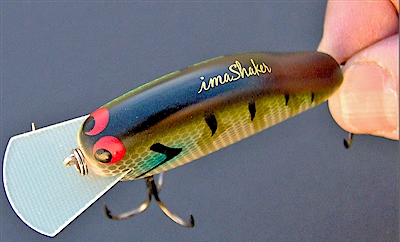
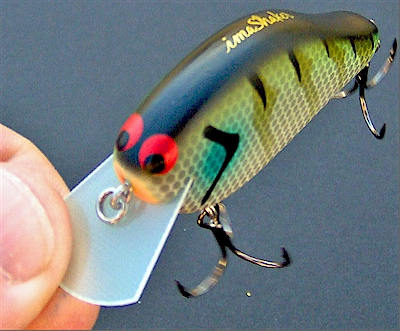
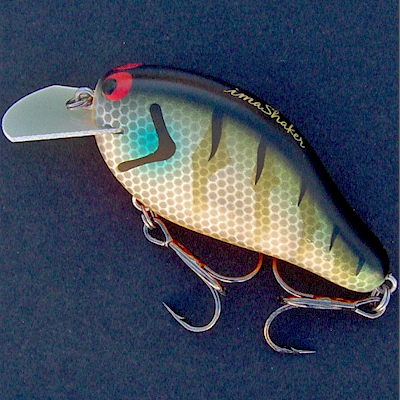
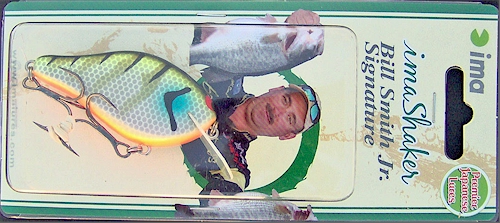
ima Shaker ~ Flat-sided Crankbait ~ Matte Bluegill
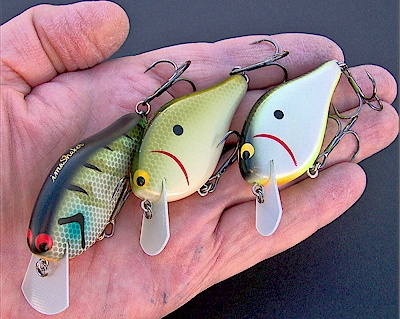
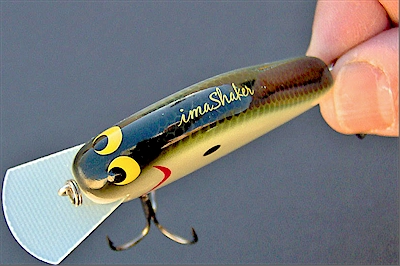
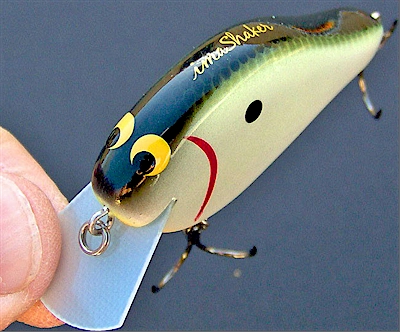
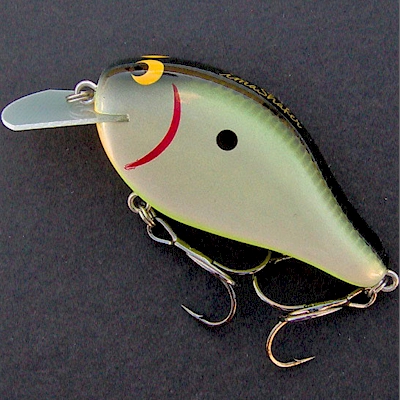
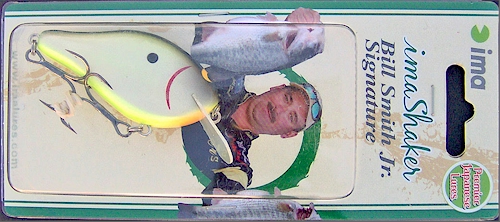
ima Shaker ~ Flat-sided Crankbait ~ Plemmons
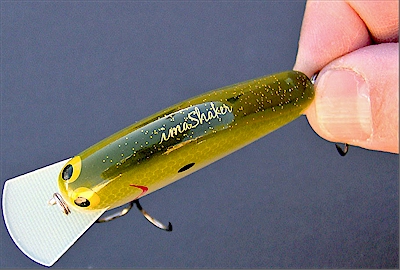
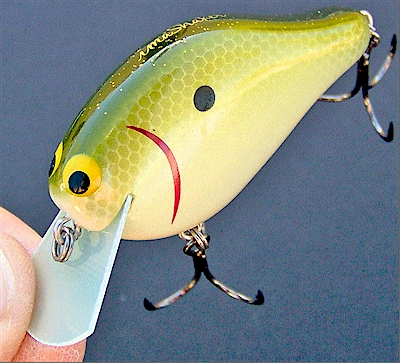

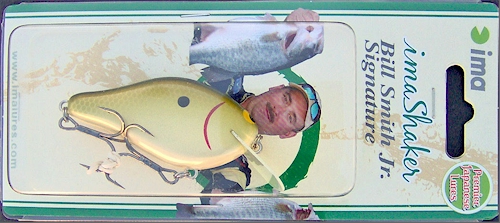
ima Shaker ~ Flat-sided Crankbait ~ Alabama Shad
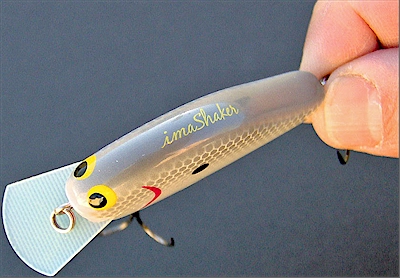
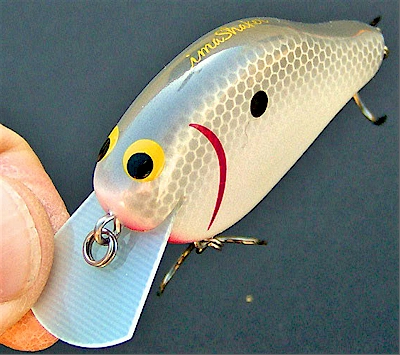
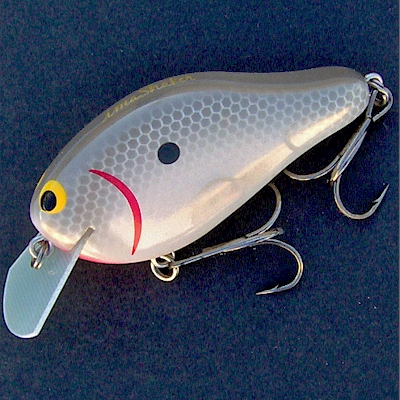

ima Shaker ~ Flat-sided Crankbait ~ White Shad

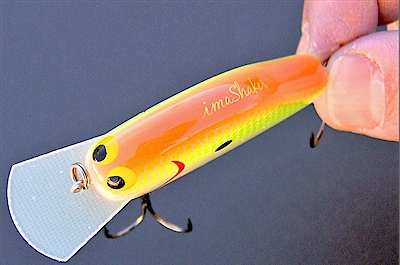
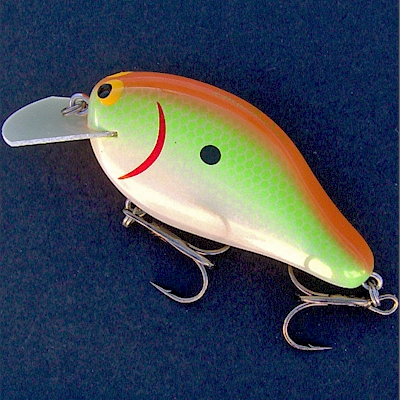

ima Shaker ~ Flat-sided Crankbait ~ Hortin
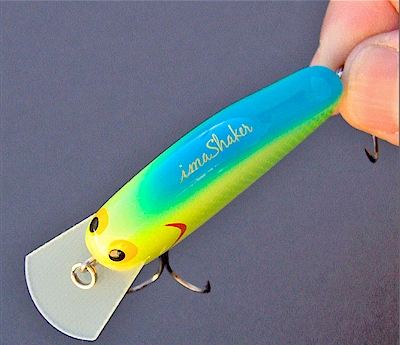

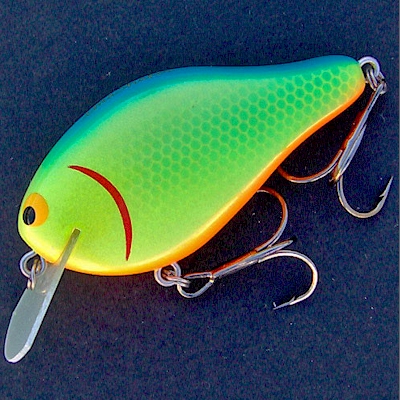
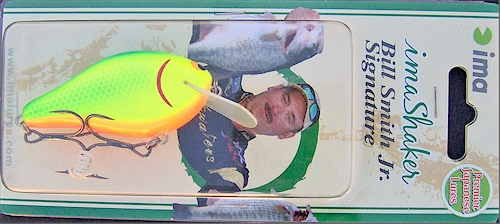
ima Shaker ~ Flat-sided Crankbait ~ Dolphin
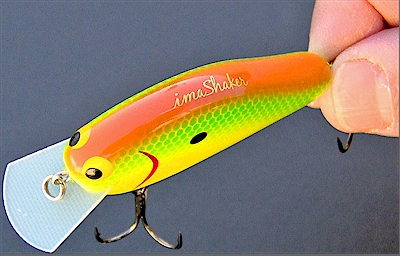

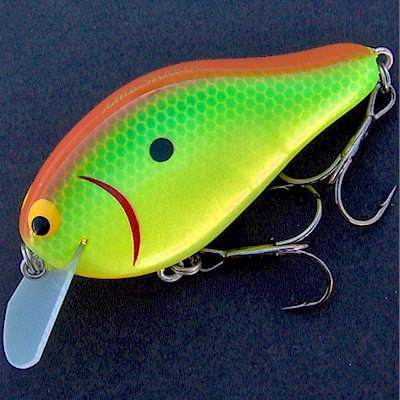
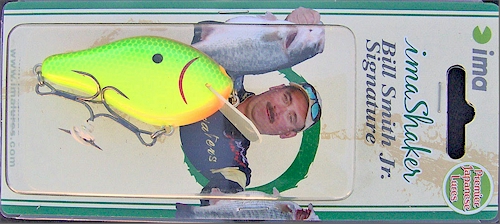
ima Shaker ~ Flat-sided Crankbait ~ Chartreuse Hortin
ima Rock N Vibe ~ Lipless Crankbait
ima's new Rock N Vibe is compact at only 2-1/2 inches long yet
weighs a full 1/2 oz and sports two oversized premium Owner
trebles that fish just can't miss.
Before tying the Rock N Vibe on your line, cup it carefully in
the palm of your hand and shake it. You'll hear and feel a
vibrancy not found in other lipless cranks. It's almost the noise
and feel of something alive in your hand, such as a cicada or
other noise-making insect.
The Rock N Vibe does not make an excessively loud noise, but
it is a more natural or vibrant noise than many other rattling
cranks. In addition to noise, the Rock N Vibe generates a high
vibration that feels like a buzz between your fingers.
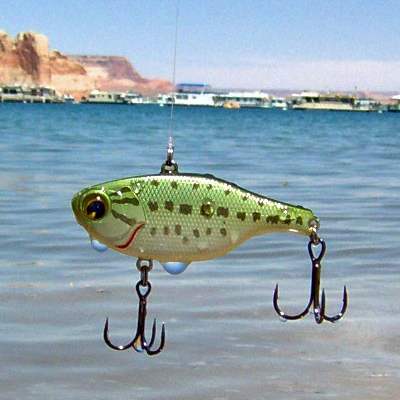
Next, tie it to your rod, hook it securely onto a rod guide
foot, and put that rod inside your car or truck with you on your
way down to the lake. As you motor down the bumpy highway, listen
to the rumbling noise made by the rapidly-vibrating Rock N Vibe
on the rod in the vehicle with you. It's more like a constant,
low rumble than a rattle. More of a shivering or quivering sound
all abuzz like some sort of insect or something alive.
As you cast the Rock N Vibe, you'll notice that rumble and
buzz manifest itself in the rod tip in a way that no other
crankbait does. It's not the way you feel a wide or tight wiggle
with other crankbaits, but it's a sort of bouncy, buzzy, vibrancy
in the rod tip.
One look at the Rock N Vibe as it nears boatside, and you'll
see that same vibrant quality in the bait's action. One way to
describe the action is to say there's a lot of side and belly
movement in the swimming behavior of the Rock N Vibe that's not
found in other lipless cranks.
The sides and belly seem to wiggle and flicker like there's no
tomorrow, and the detailed color patterns simply dance and play
like alive. It has a rather realistic baitfish swimming movement
and action compared to the more mechanical and artificial actions
of many other lipless cranks. It's a work of art, imitating life.
When paused, the Rock N Vibe falls straight and true. It is a
true countdown lure since it won't tangle the line as it falls.
Most all lipless cranks sink, but many spin or foul the line as
they do, so they're really not useful for counting down to deeper
depths. That's the last thing you want - a lipless crank that
fouls itself when it falls or is paused, ruining cast after cast.
The Rock N Vibe won't do that. It falls perfectly true when
paused or on the sink, making it useful to countdown to various
depths.
This doesn't mean the Rock N Vibe will never tangle. When
popped sharply on a lift-and-fall or jigged erratically using a
yoyo presentation, any bait will occasionally tangle. It's just
the nature of such techniques. However, the Rock N Vibe's ability
not to tangle on a typical stop-and-go or jerk-and-pause approach
is a key design feature since fish often hit on such pauses or
change-ups in the action.
Plus the Rock N Vibe will stay down at the depth it was
counted down to. Most other lipless cranks won't do that. Even if
you can count them down without fouling themselves, many lipless
cranks tend to rise up higher like kites once the retrieve is
started, not staying at the desired depth like the Rock N Vibe
will for you.
Feeling reckless? Try 'worming' the Rock N Vibe along bottom
in deeper water as if you'd fish a worm or jig. Don't flatter it
by treating it in any special way. Totally disregard that you
even have a lipless crankbait tied on, just hop and drop it the
same way you'd work a worm or jig! The perfect, controlled
sinking behavior of the Rock N Vibe is ideally suited for
'worming' it this way in deep water.
The fact you can worm it hits upon another valuable feature of
the Rock N Vibe. You can use it at any retrieve speed. This bait
can be fished at any speed from painstakingly slow to blazingly
fast and all speeds in between. So whether the bass just want to
lazily suck it in or aggressively chase it down, the Rock N Vibe
will match the mood.
The Rock N Vibe is as much at home on medium spinning gear as
on baitcasting, and it casts like a rocket on either outfit.
Give it a try and you'll see why the pudgy little Rock N Vibe
has that watchful eye and worrisome look on its face, because
some big bully of a bass is constantly chasing after it!
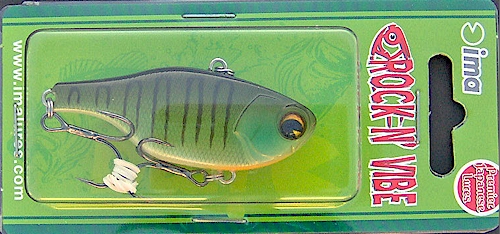
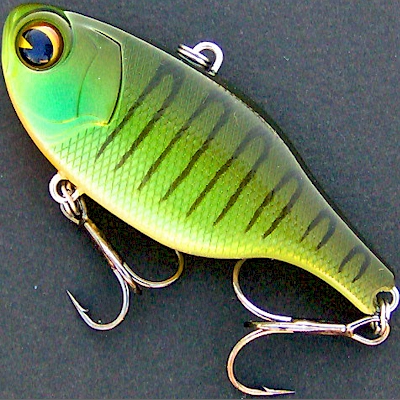
ima Rock N Vibe ~ Lipless Crank ~ Matte Bluegill
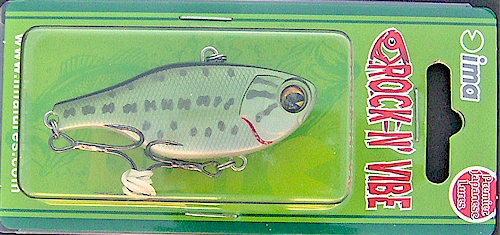
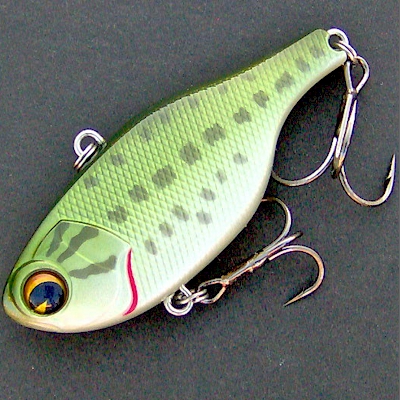
ima Rock N Vibe ~ Lipless Crank ~ Baby Bass
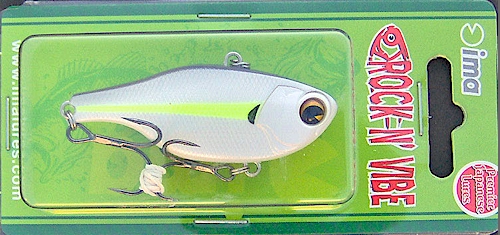
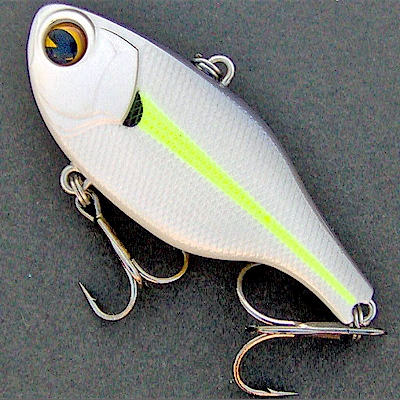
ima Rock N Vibe ~ Lipless Crank ~ Chartreuse Shad
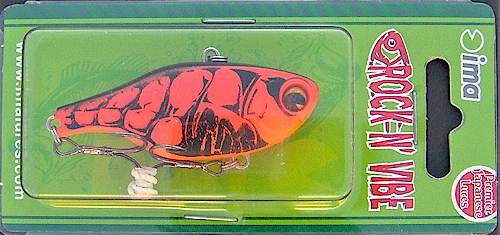
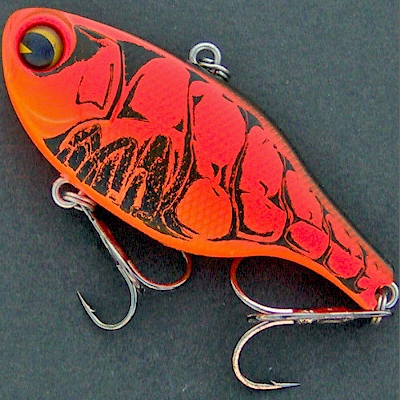
ima Rock N Vibe ~ Lipless Crank ~ Hot Craw
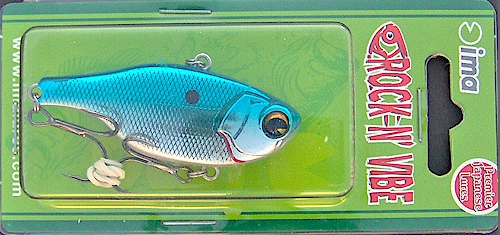

ima Rock N Vibe ~ Lipless Crank ~ Chrome Blue Back

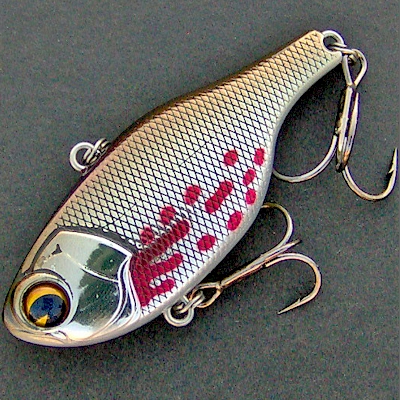
ima Rock N Vibe ~ Lipless Crank ~ Wounded Shad
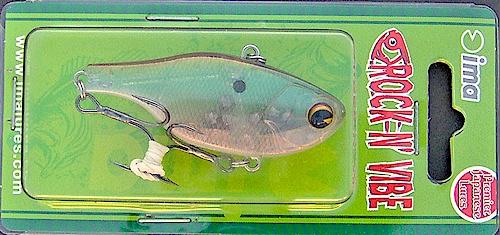
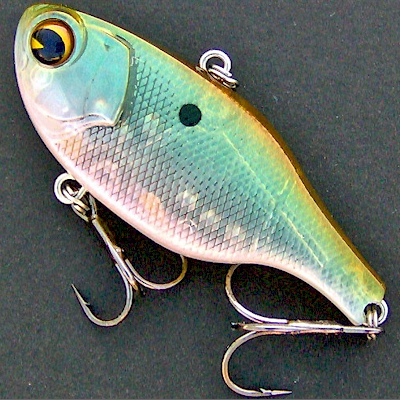
ima Rock N Vibe ~ Lipless Crank ~ Ghost Minnow
|
